Individual families have a need for radio communications, often referred to as Walkie Talkies, when engaging in many routine activities. Some of these activities are made easier with radio while other activities find the use of radio to be essential to the efficient conducting of said activity. Therefore, the need for radio communications does not start with public safety and stop with business. It extends to personal use of radio. Recognizing that need, the FCC has authorized several services that cater to the personal use of radios. Which is the best walkie talkie for you?
The first and most obvious use of radio is the cellular phone. Cellular phones are radios with an exotic user interface that perform a wide variety of functions. However, the use of a cellular phone is not the most efficient method of conducting activities that happen in real time and involve more than two or three people. Limitations of cellular phone include the following:
- Only 2 or 3 people can be on a phone call at any time (without involving a conference bridge) which is a big limitation when conducting real time activities that require instant communications.
- It takes time to dial a number and time for the phone to start ringing.
- Sometimes calls go directly to voice mail or drop in the middle of a conversation.
- There must be cellular coverage in the area you are conducting the activity, or the phones will not function at all.
Radio systems eliminate the above drawbacks of the cellular phone. However, they come with their own set of limitations just like any other radio system. Depending upon what you are trying to accomplish with the radio system will determine what you need to do in order to achieve the required communications.
Note: There are many terms used in this article that are explained in the “Glossary of Terms” found elsewhere on this website.
Most family use of radio is over a limited distance which is easily handled by a simplex radio system. This type of radio system talks directly from one radio to another radio without the help of any fixed infrastructure which makes it easily moved from one area to another. The problem with this type of radio system is that the range is limited, especially in the city where there are many buildings and other obstructions. Another issue is that the range of the radio is dependent upon the location of the radio. Since radio signals travel primarily line-of-sight, radios located at a higher location such as on top of a hill or on the higher floors of a building will have better range. Therefore, each radio will talk a different distance depending upon its location.
For a complete discussion on the distance or range that a radio will talk, please see the article,How Far Will My Radio Talk
There are several radio services that are set aside for personal use. They are:
- Citizens Band (CB) Radio Class D CB 27MHz
- Family Radio Service (FRS) at 462MHz / 467MHz
- General Mobile Radio Service (GMRS) at 462MHz / 467MHz.
- Multi-Use Radio Service (MURS) which has 5 channels in VHF 151-155MHz
- Amateur Radio (which has several frequency bands)
- NEXEDGE Digital Commercial Radio
CITIZENS BAND (CB) – CLASS D 27MHz
The 27MHz Citizens Band is typically used by truckers to keep in touch with each other as they drive down the road. It is also used by people with fixed base stations to chat with each other. All these radios operate simplex (see below for an explanation) so the range you get on the radio is just what the radio will do on its own without the help of any infrastructure. The CB radio was featured in the movie Smokie and the Bandit in which The Bandit used the CB radio to help avoid capture by the police and coordinate their “illegal” attempt to bring their beer across state lines. These radios work well for distances of typically up to 10 miles, but often get “skip” which allows the radio signal to travel great distances at times that are not always predictable. Therefore, there are times that you can talk to someone 2000 miles away, but you are not able to speak to someone else that is only 20 miles away. The 27MHz CB radio has a big antenna (approximately 8 feet long) that is not suitable for portable hand-held walkie talkie type radios, so portable radios are not as plentiful as mobile radios and base stations. There are thousands of people who use CB radio, so even though there are 40 channels (80 channels if you are using a SSB radio) it is common to find hundreds of people occupying the same channel at any given time. This makes using this radio for coordinating an event or activity problematic. The best use of this type of radio is being able to talk to each other while caravanning down the road or keeping in touch with others while camping in remote areas. It can be used with walkie talkies, but these portable radios will have rather large antennas which tend to be unwieldy under many circumstances.
We do not sell CB radios or accessories. They are available from many vendors.
FAMILY RADIO SERVICE (FRS)
Family Radio Service is an unlicensed Radio Service in the 462MHz band. The FRS channels are half-way in-between the GMRS channels, operate on 12.5KHz narrowband channels and are used strictly used in simplex mode direct radio to radio without the help of a repeater. FRS radios are limited to a low power of 500 milliwatt (0.5 watt) on 7 of the channels (which includes 467.5625-467.7125MHz) with an integral antenna so that the user cannot use a higher gain antenna to extend the range of the radio. The power is limited to 2 watts on the other 7 channels (which includes 462.5625-462.7125MHz) with an integrated antenna. FRS radios will receive interference from nearby GMRS radios because the channels are half-way between the original GMRS channels, but they overlap the GMRS channels. (See our article on adjacent channel interference for a discussion of the effects of having overlapping channels.) Due to the change in regulations in 2017, GMRS is now allowed to operate on the FRS frequencies at a significantly higher power then FRS. Since the FRS equipment is operated under FCC Part 15, any interference you receive from others must be accepted because there is no right to demand any action to clear up the interference. The range of the radio is typically about 6 blocks in the city on reasonably flat terrain and about 1-2 miles in rural areas, however these numbers can vary widely depending upon obstructions and terrain.
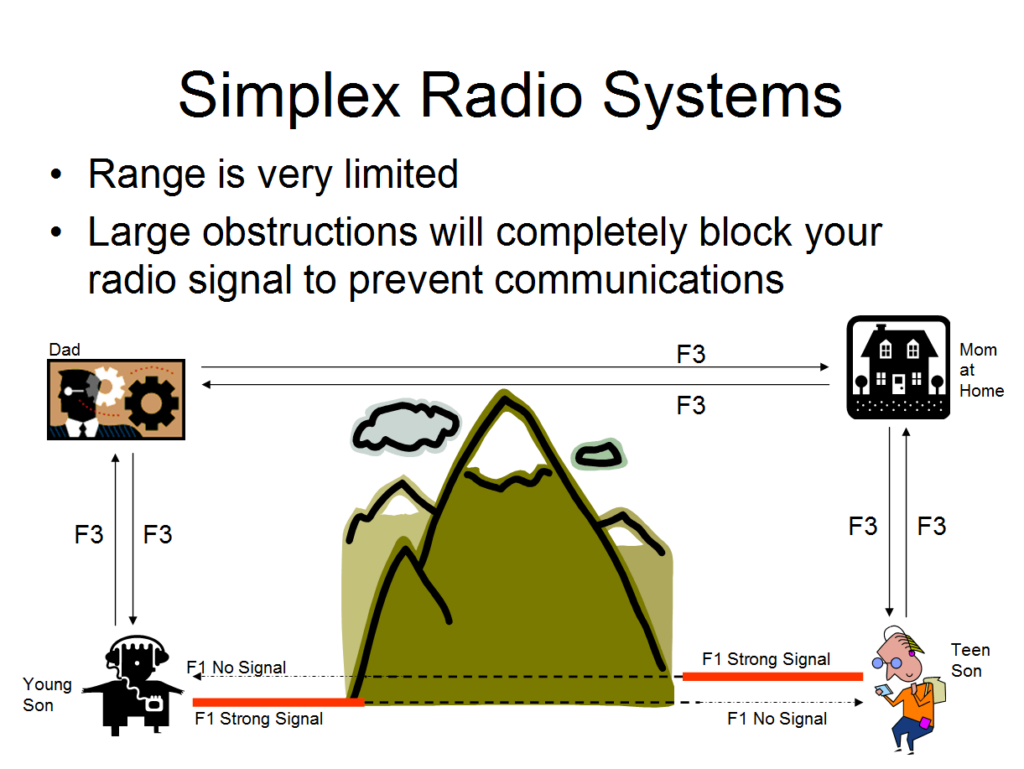
In the example above, the young son cannot talk to the teenage son because of the large hill between the two of them. However, the young son can talk to dad. Dad can relay the message to mom at home. Mom at home can talk to the teen son. This way, the message can be passed by relaying the message from one person to another. This is a typical limitation of simplex radio systems where it is common for each radio to have a different coverage area because the line-of-sight is different from each location.
The FRS radio is the most common method of providing family communications. These radios are readily available from places such as Wallmart, Best Buy, Target and many stores that sell electronics. The FRS radios are all walkie talkie portables and they sell for typically $50 per radio. They are simplex radios, so they can be taken almost anywhere and provide reliable short-range communications. Click here to view FRS Radios
GENERAL MOBILE RADIO SERVICE (GMRS)
The next method of providing radio communications for the family is General Mobile Radio Service (GMRS). GMRS must be operated with a license by someone within the family which allows anyone in the family to use the radios. The radios are only for personal use unless you were licensed prior to July 31, 1987 in which case you can continue to use the radios for business use provided no major changes are made to the license. The original frequencies are wideband channels which are a 20KHz wide transmission on 25KHz centers, so they do not overlap each other. (Unfortunately, the FRS channels discussed above are halfway in between the main GMRS channels, so there can be adjacent channel interference depending upon a variety of circumstances that are too numerous to discuss in this article. In 2017, GMRS was authorized the 12.5KHz offset channels in between the original GMRS channels which are the same as the FRS channels mentioned above, so the GMRS channels can receive considerable adjacent channel interference.) GMRS channels are paired frequencies, meaning that there is a receive frequency and a transmit frequency which make the ability to operate a repeater to extend the range of the communications. (A complete discussion of Conventional Radio systems including repeaters is elsewhere on the website.) If the repeater is located on a tall tower on flat terrain, the range of the repeater would be circular around the tower with the best signal being close to the tower with the signal strength decreasing with distance from the tower until the signal gets too weak to be usable. The range of the repeater would be primarily dependent upon the height of the antenna above ground on the tower and transmitter power. When placing the repeater on top of a hill or mountain, the coverage is typically not circular because the mountain itself blocks the line-of-sight from the antenna location in certain directions, thus creating an irregular coverage pattern. This effect can be seen in the coverage maps we have posted on the website for over 400 popular repeater locations.
Repeaters are radios that receive and transmit simultaneously, therefore they operate full duplex. Their purpose is to extend the range of radio communications by relaying the radio transmission from an advantageous location that can hopefully provide reliable communications to all areas where coverage is desired. Repeaters re-transmit any radio transmission that it hears on the receive frequency onto the transmit frequency, but since the repeater is at a high location, the line-of-sight distance from the repeater is much greater than the line-of-sight distance from the user’s radio who is attempting to talk to someone else who is not at a high location. All user radios transmit on the receive frequency of the repeater and all radios listen to the transmit frequency of the repeater, so anything said can be heard throughout the coverage area of the repeater. The problem with this type of radio system is that it only works when you are in range of the repeater and since most repeaters are at fixed locations, the ability to move the repeater and set it up in a new location is often difficult or impractical. That makes these radio systems difficult to relocate for family outings into areas where there is no radio coverage from the repeater. A common way to get around the issue is to have both a repeater channel for when you want reliable wide area communications and have a simplex channel for when you want to be able to take the radios anywhere. However, the simplex channel will generally never have the same range as the repeater system. (See discussion of the range of simplex radios above.)
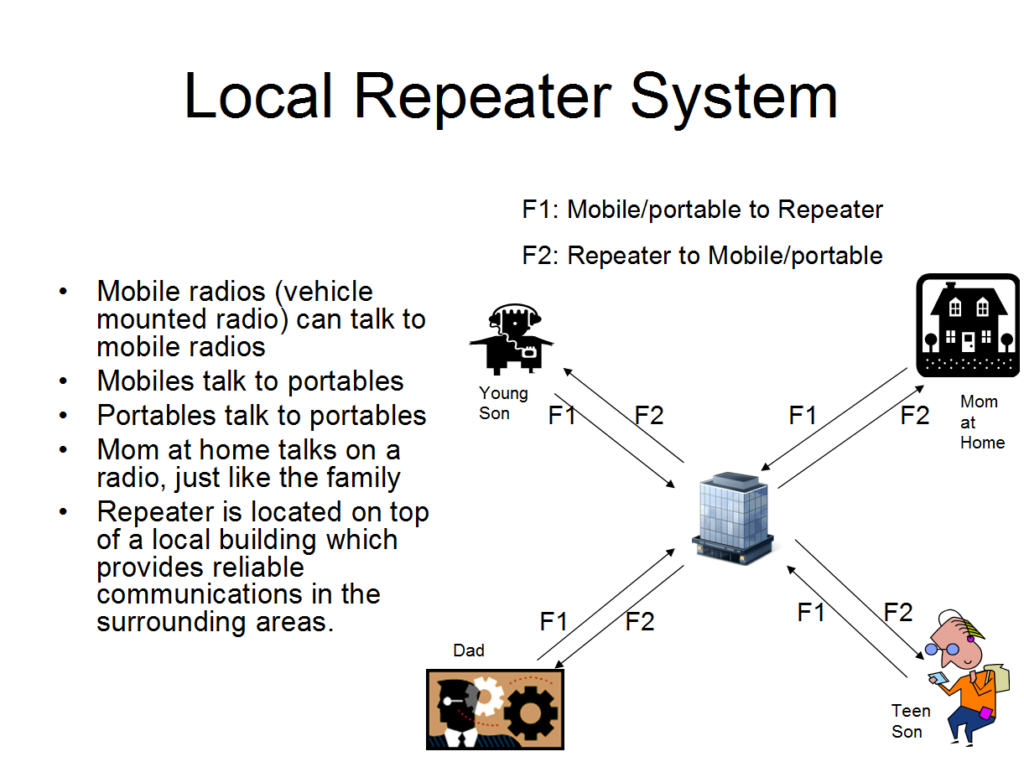
Above is a diagram of a repeater system that depicts all the user radios transmitting to the repeater on frequency F1 and listening to the repeater on frequency F2. By placing the repeater on top of a tall building, the line-of-sight distance is much greater (several miles) and thus it is possible to talk over the area that can be seen from the top of the building. If mom wants to talk to dad, the radio transmits on frequency F1 to the repeater which repeats the signal with the repeater transmitter on frequency F2. Dad’s radio listens on frequency F2 and hears mom talking. When dad answers, dad’s radio transmits on frequency F1 which is heard by the repeater. The repeater re-transmits the signal with the repeater transmitter on frequency F2 which is heard by mom’s radio that listens to frequency F2. Both kids can hear the conversation between mom and dad since their radios listen to the repeater on frequency F2 because they are in same area and in range of the repeater. With repeater systems, all the radios have the same range which is determined by the location of the repeater.
The advantages of a repeater system are many. Here is what you can expect from a repeater system:
- Once you have sufficient signal to be heard by the repeater receiver, you can talk to anyone within range of the repeater.
- All equivalent radios have the same ability to reach other radios that are within range of the repeater.
- Higher power radios such as mobile radios can reach the repeater easier than portable radios for several reasons which include:
- Mobile radios are higher power than portable radios
- Mobile radios have a better and more efficient antenna than a portable radio.
- Mobile radios are not inside buildings, elevators, or other vehicles under normal circumstances.
- Portable radios are often inside buildings, basements, elevators or inside the cab of a vehicle which creates high signal loss while attempting to talk to the repeater.
- Holding the portable radio with the antenna horizontally or laying the radio on the seat of a vehicle will cause additional signal loss and reduce the reliability of communications.
- Higher power radios will be able to reach the repeater easier, but once the signal is repeated by the repeater transmitter, the range is the same talking out from the repeater to the user radio regardless of how strong the signal was into the repeater provided the signal to the repeater was good enough to be usable.
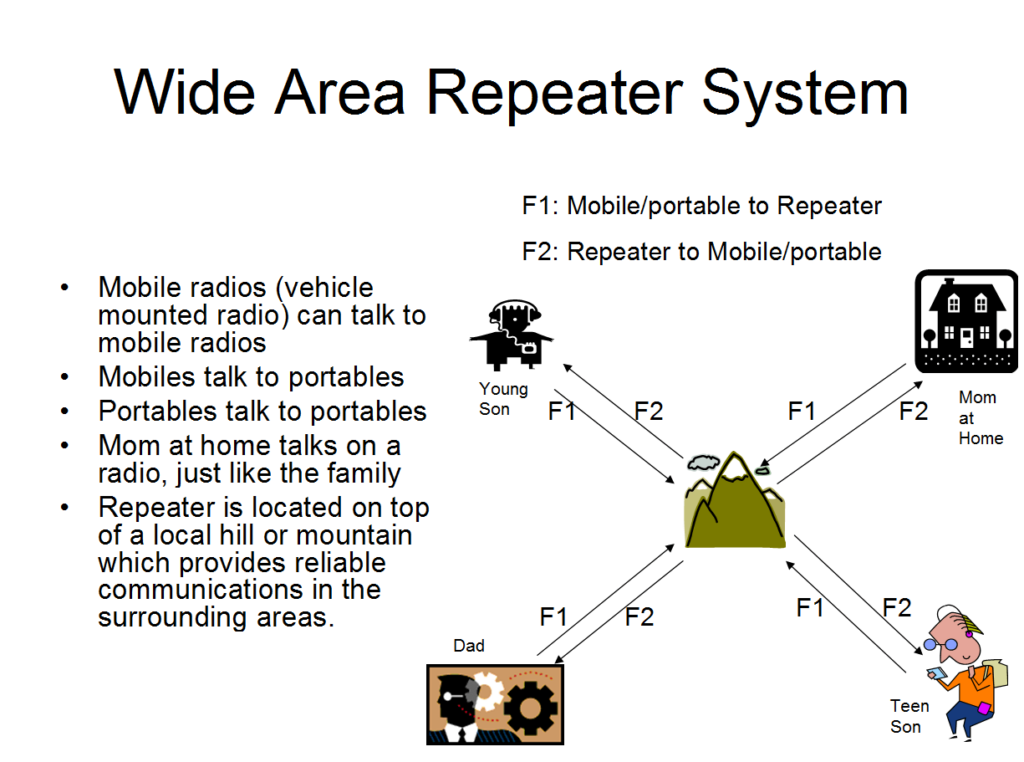
By placing the repeater on top of a large hill or mountain, the line-of-sight distance is much greater (20-75 miles) so communications are possible over a much greater distance. However, once you leave the coverage area of the repeater, there is no communication whatsoever because the radios transmit on one frequency (F1) and receive on another frequency (F2) without anything to repeat the transmission from one channel to another.
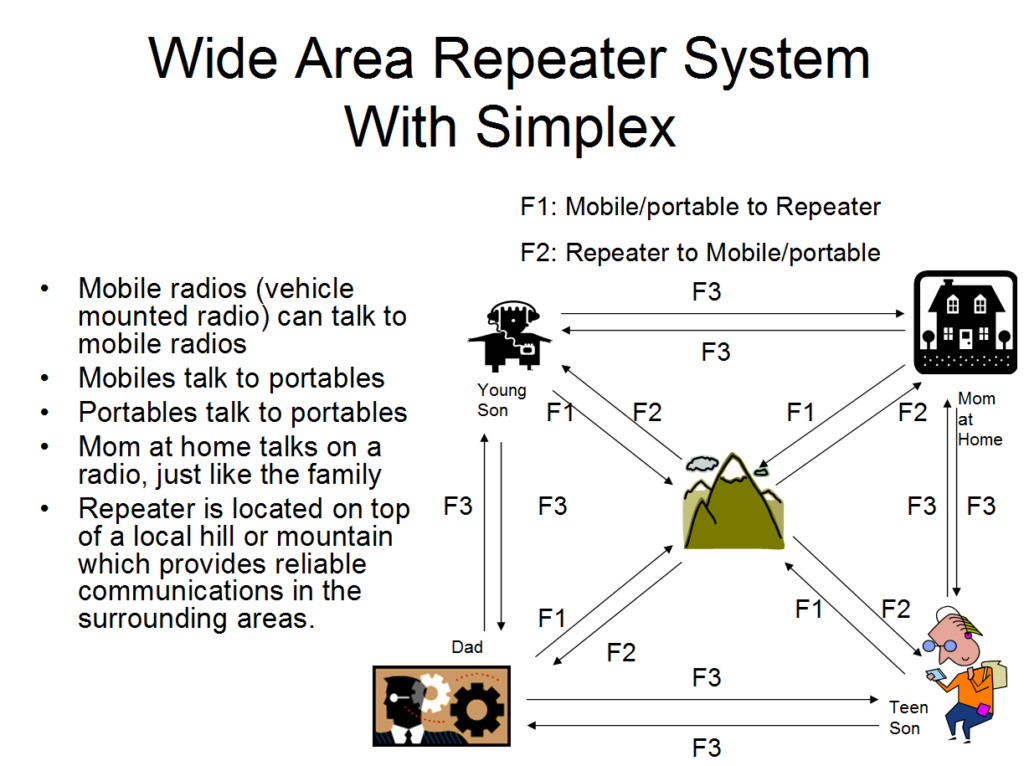
The repeater above is the same as the previous diagram, however, when you are out of range of the repeater, you can switch to the simplex channel where the radios talk and listen on the same frequency F3. The simplex channel will operate anywhere you take your radios without the repeater, but the range of the radios will be limited to about 6 blocks in the city and 1-2 miles in rural areas. If one of the simplex radios is on high ground, you can see farther away and therefore it will be able to talk further than the other simplex radios. Since the simplex channel is a separate frequency not associated with the repeater, when you are on the simplex channel, you will not hear any transmissions from the repeater and vice versa.
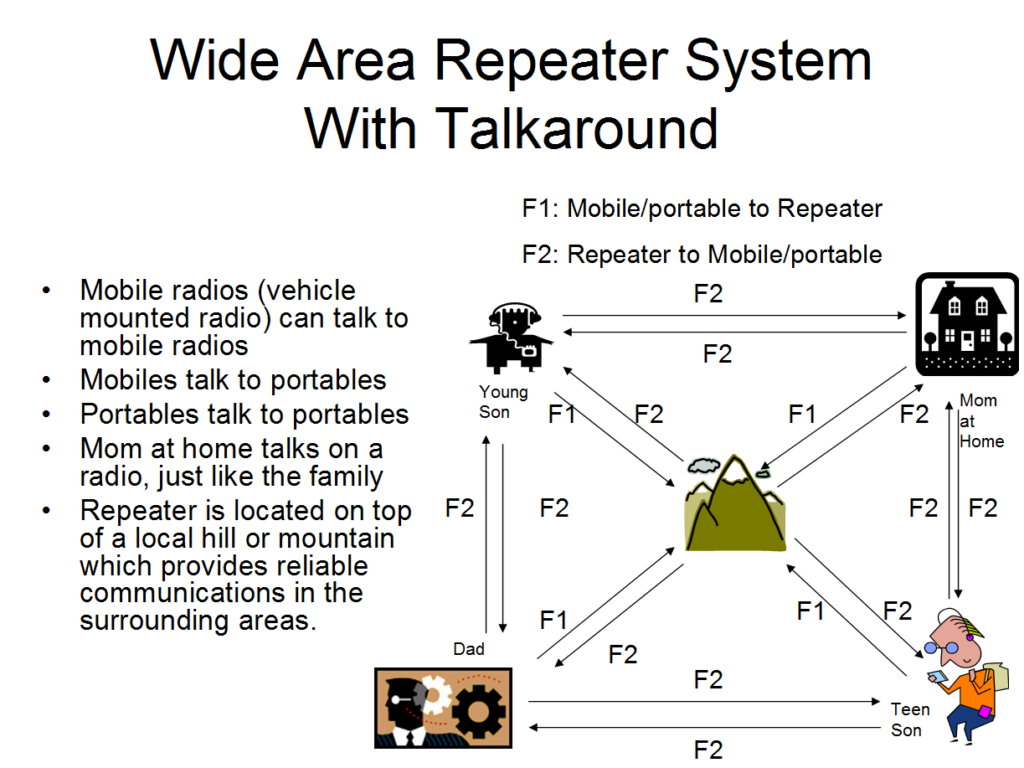
Talkaround is the same thing as the previous example of a repeater system with simplex, except that the simplex frequency is the same as the repeater transmit frequency. The repeater above is the same as the previous diagram, however, when you are out of range of the repeater or you want reliable short range communications, you can switch to the radio to transmit and receive on the same frequency F2 as the repeater transmitter. This allows you to operate simplex talking direct from one radio to another radio without the help of the repeater, but since you are using the repeater transmit frequency, you can still hear someone talking on the repeater if you are in range of the repeater. However, when using the radios simplex, if someone talks on the repeater at the same time as another who is talking simplex, the two signals can interfere with each other so the simplex operation of the radios may not work properly while the repeater is transmitting. This is determined by which signal is stronger at the receiver. As an example, if the teen son is talking to his dad, dad may hear him or may hear mom talking through the repeater which is determined by who has the stronger signal; mom talking to dad through the repeater or the teen son talking on the talkaround frequency F2 to dad. Both can be heard since they are one and the same frequency, but not necessarily at the same time. Raycom sells GMRS radios. Click here to view GMRS radios: GMRS Radios
MULTI-USE RADIO SERVICE (MURS)
MURS radios operate license free in the VHF band between 151MHz and 155MHz. There are 5 frequencies available for use. There is a wide selection of radios that can operate on the MURS frequencies which are available for use on the MURS frequencies from the inexpensive ProTalk radios to high tier expensive radios such as the Kenwood NX-5200. The VHF band has some propagation advantages over GMRS and FRS radios that utilize the UHF band because of the lower radio frequency. The lower frequency also affects the wavelength of the radio signal by making it 3 times as long. This makes the antennas 3 times as long unless you have a helically wound antenna on the portable radio which is common. VHF radio signals will bend around hills better than UHF, so when you are in irregular terrain, the VHF radio will generally perform better than UHF radios. However, when inside buildings, the UHF radio will generally perform better than the VHF radio because the shorter wavelength of the radio signal can easily get through smaller openings in the structure to get to where you are located within the structure.
All MURS radios operate simplex just like the FRS radios. The simplex operation of the MURS radios is just like the simplex operation of the FRS radios described above in the FRS radio section. These provide reliable communications over a limited distance
MURS radios are available from Raycom. Click to see MURS Radios: Click to see MURS Radios
AMATEUR (HAM) RADIO
Amateur radio is a licensed radio service but is quite different than any of the other services listed above. Amateur radio is a hobbyist radio service where the purpose of the service is to foster interest in radio and the development of expertise in the use of radio. Many people who work in the commercial radio are also amateur radio operators (aka “Ham Radio”) because the service is used to develop the technical expertise of the people by giving them a “playground” to be able to experiment with the use of radios, determine their limits and possible applications. Each person who uses amateur radio must take a written test for which most people need to study to pass the test. There are classes given in amateur radio to pass the written test. The license is not transferrable and is individual to the person who obtains the license. Therefore, if you wish to use amateur radio to communicate, each member of the family must obtain a license.
Amateur radio offers significant flexibility over any of the other radio services. First, there are many amateur radio frequency bands which offer the flexibility of different types of radio propagation characteristics to fit the specific need for whatever you are attempting to accomplish. For instance, if you were going on a sailing expedition, having a HF amateur radio would allow you to communicate over distances of many thousands of miles to other amateur radio operators who could forward your message to whomever needs to receive the message. Some amateurs have “phone patch” capability so they can tie the telephone into the radio and allow you to speak to your relatives or friends from the middle of the ocean over a connection established by another amateur operator who is somewhere on land. Amateur radio has been in use in space which allows the astronauts to talk to people on the ground without going through mission control, is used my most scientific expeditions in Antarctica for a recreational pastime and is used by hundreds of thousands of people to visit and converse with people who are friends and acquaintances.
Many amateur radio operators build large communications networks that allow reliable portable radio communications over large geographic areas that are either free to use or require a modest monthly “subscription” fee to support the cost of running the network. Amateur radio operators often provide communications for special events as part of the “public service” aspect of amateur radio and often participate in emergency communications when disaster strikes. Most people who become amateur “ham” radio operators do so because they have a true interest in the art of radio and want to become more adept at the use of the radio. The personal communications available through ham radio are numerous, but is generally not for people who have no interest in radio for the sake knowing radio.
Raycom does not sell amateur radio equipment per se, but many of the products that we sell are used by ham radio operators in building their networks. When you get to the advanced level of amateur radio, the professional level products that we offer are essential for the operation of the network. Also, our radio tower sites are often used by ham radio operators to provide coverage for their networks.
Click here to view our repeater equipment: Repeaters
NEXEDGE DIGITAL RADIO
Our NEXEDGE Diga-Talk network is a high-end solution to personal communications that incurs a monthly subscription fee for the use of our communication network. Many people who use radios for personal use do so for the purpose of search and rescue in rural areas. Our Diga-Talk network has large amounts of coverage in rural areas which allows you the ability to communicate from your house large areas including rural areas where search and rescue operations are conducted. Having our Diga-talk radios can provide you with reliable communications.
Click here to read about our Diga-Talk network: Diga-Talk Network
SUMMARY
Radio Range Review
With simplex radios, the range is dependent upon the obstructions between the radios so the range is relative to the situation. When you are inside a building, you may only be able to talk across the floor of a large building or maybe a few floors inside a high rise building while you can talk a few blocks outside buildings in the city or 1-2 miles in the rural areas depending upon terrain. If you are on the salt flats, you could talk 10 miles and if you were on a mountain looking down on a valley, you could talk for 20-50 miles if the line-of-sight is that far. If you can see it, you can talk to it. However, the applicable situations where you can communicate 20-50 miles are very few and far between.
When considering repeater systems, the coverage depends on the height of the antenna, transmitter power, and frequency. Repeaters typically offer greater coverage than simplex systems and can operate over long distances when placed on high structures. A repeater placed on a tall mountain can provide a range of 20-75 miles.
RADIOS FOR PERSONAL COMMUNICATIONS
The following are the different types of radios for personal use:
- Cellular phones – most people already have one, but needs cellular coverage
- FRS Radios – Most popular method of personal communications
- GMRS Radios – Greater range and flexibility than FRS
- MURS Radios – Similar to FRS, but channels are typically less crowded and they get better range in hilly or mountainous areas
- Amateur Radios – the most options and flexibility, but typically for radio enthusiasts
- Diga-Talk Network Radios – for the very serious who often participate in search and rescue or go into areas not covered by other services
When it comes to choosing a service, it is essential to evaluate the advantages and disadvantages associated with each option. By carefully considering factors such as purchase price, monthly operating costs, flexibility, and radio coverage, you can determine which service aligns best with your individual needs. One important aspect to consider is the purchase price. Different services may vary in terms of upfront costs, and it is crucial to assess your budget and financial capabilities before making a decision. Some services may have lower purchase prices, while others may require a higher initial investment. It is vital to weigh the cost against the benefits you expect to derive from the service. Additionally, monthly operating costs play a significant role in determining the overall affordability of a service. While some services may have a lower purchase price, they may come with higher recurring expenses. On the other hand, certain services may have higher upfront costs but lower monthly fees. It is crucial to calculate the long-term costs and determine which option fits within your budgetary constraints. Flexibility is another crucial factor to consider. Different services may offer varying degrees of flexibility in terms of customization and scalability. It is essential to assess whether a service can adapt to your evolving needs and accommodate any potential growth in your business or personal requirements. Some services may provide more flexibility in terms of adding or removing features, while others may have limitations in terms of customization options. Furthermore, radio coverage is an important aspect that should not be overlooked. Depending on your location and intended usage, the coverage provided by different services may vary. It is crucial to ensure that the service you choose offers reliable coverage in the areas where you will be using it the most. Conducting thorough research on the coverage maps and customer reviews can help you gauge the reliability and reach of each service. Selecting the right service requires careful consideration of various factors such as purchase price, monthly operating costs, flexibility, and radio coverage. By evaluating these aspects, you can make an informed decision that aligns with your individual needs and priorities.
